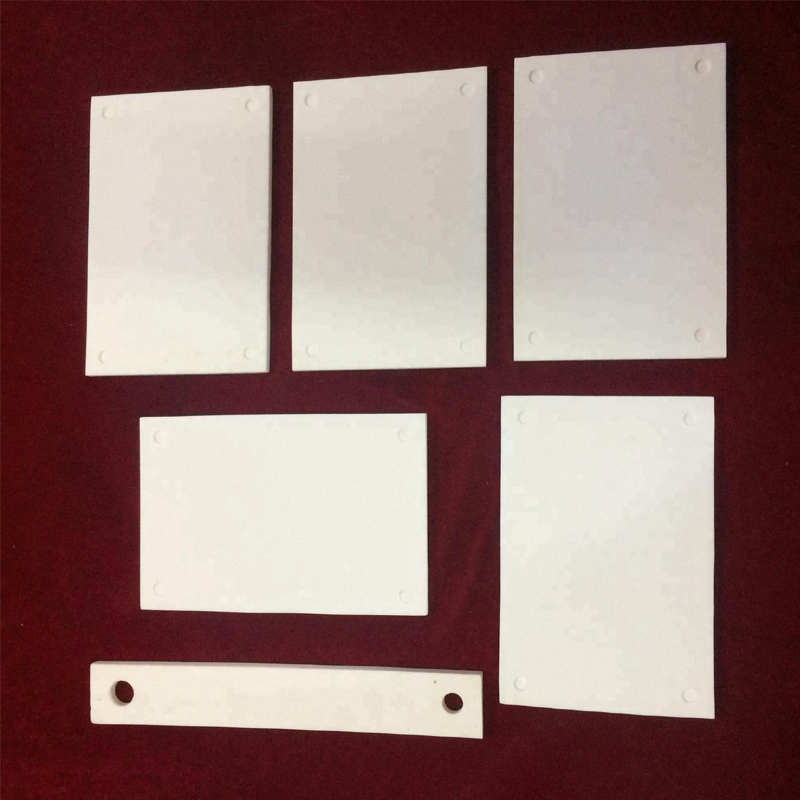Large scale comparison of performance of ceramic substrates made of different materials

In the field of electronic packaging, ceramic substrates, with their excellent electrical, thermal and mechanical properties, have become key materials that support the stable operation of electronic devices. Ceramic substrates made of different materials each exhibit unique performance characteristics and play an important role in various application scenarios. Today, let's take an in-depth look at several common types of ceramic substrates and compare their performance differences.
Alumina (Al₂O₃) Ceramic Substrate
The alumina ceramic substrate is one of the most widely used ceramic substrates at present. According to the different contents of aluminum oxide, the commonly seen ones are 96% alumina ceramic substrate and 99% alumina ceramic substrates.
The 96% alumina ceramic substrate has high hardness, strength and wear resistance. It has a relatively low cost and good processing performance, and can be processed by cutting, drilling and other methods. In applications with low temperature and low electric field strength, its dielectric constant and dielectric loss perform excellently, and the signal transmission performance is good. However, its purity is relatively lower than that of the 99% aluminum oxide substrate, and its dielectric constant and dielectric loss are also slightly higher. It is prone to brittle fracture in a high-temperature environment.
The 99% alumina ceramic substrate has higher chemical purity, density and hardness, excellent electrical properties, a relatively high dielectric constant and a low dielectric loss. It has excellent high-temperature stability and can withstand temperatures up to 1700℃. It also has high mechanical strength and strong corrosion resistance. In addition, it can be prepared into a relatively thin alumina ceramic substrate, which is beneficial for the preparation of microelectronic devices. However, its cost is relatively high, and the processing difficulty is also greater.
2. Application Fields
The 96% alumina ceramic substrate is commonly used in the fields of low-power electronic components, sensors, capacitors, miniature relays, microwave components, etc. In these scenarios where cost is a sensitive factor and the performance requirements are relatively less stringent, it can give full play to its advantages. The 99% alumina ceramic substrate is more suitable for the fields of high-power LEDs, high-voltage integrated circuits, high-temperature sensors, high-frequency electronic components, etc., meeting the strict requirements of these fields for the high-temperature stability, electrical properties and mechanical strength of the materials.
Zirconia (ZrO ₂) ceramic substrate
1. Performance Characteristics
The zirconia ceramic substrate is characterized by high strength and high hardness. Its hardness can usually reach above HRA90, and even as high as HRA95, which is more than 10 times that of steel. Its strength can reach 900MPa at room temperature and still maintain a relatively high level at high temperatures. It has good wear resistance and a high surface flatness.
Zirconia ceramics have strong chemical inertness and excellent corrosion resistance. They are not easily eroded by chemical substances such as acids and alkalis, and can operate stably for a long time in harsh environments. Its insulation performance is also very outstanding, making it suitable for high-voltage insulation materials. In addition, zirconia ceramics have an extremely high melting point and high-temperature stability, and can be used for a long time in high-temperature environments.
2. Application Fields
It is widely applied in fields such as high-end manufacturing, electronics, aerospace, medical devices, and chemical engineering. In the electronics field, it can be used to manufacture sensors, capacitors, etc. In the medical device field, due to its good biocompatibility, it can be used to make implants such as artificial joints.
Silicon Carbide (SiC) Ceramic Substrate
1. Performance Characteristics
The silicon carbide ceramic substrate has an extremely high hardness, which is 5 times higher than that of steel and 3 times higher than that of aluminum. It also has a high strength, and its tensile strength can reach more than 400MPa. Silicon carbide has good high-temperature resistance, with a high melting point, and can withstand high-temperature thermal shock. Generally, its service temperature ranges from 1200℃ to 1600℃.
It has strong oxidation resistance and can resist high-temperature oxidation corrosion, and can be stably used in the air. Silicon carbide has good wear resistance, high hardness, and a small friction coefficient. At the same time, it has excellent thermal conductivity, which is 2 to 3 times that of metals, enabling effective heat dissipation, and it also has good chemical stability.
2. Application Fields
Ceramic substrates made of different materials have their own advantages and disadvantages in terms of performance. In practical applications, it is necessary to comprehensively consider factors such as thermal conductivity, insulation, mechanical strength, cost, and processing difficulty according to specific requirements, and select the most suitable material for the ceramic substrate. With the continuous development of electronic technology, the requirements for the performance of ceramic substrates are also constantly increasing. In the future, ceramic substrates of various materials will continue to innovate in terms of performance optimization and cost control.

